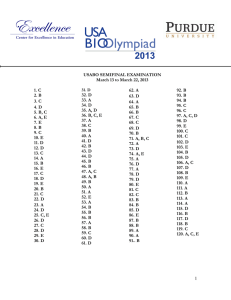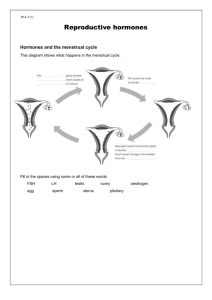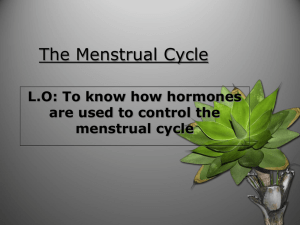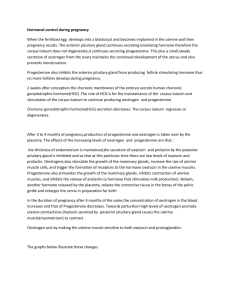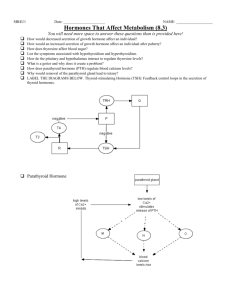2. endocrine control of the oestrous cycle
advertisement
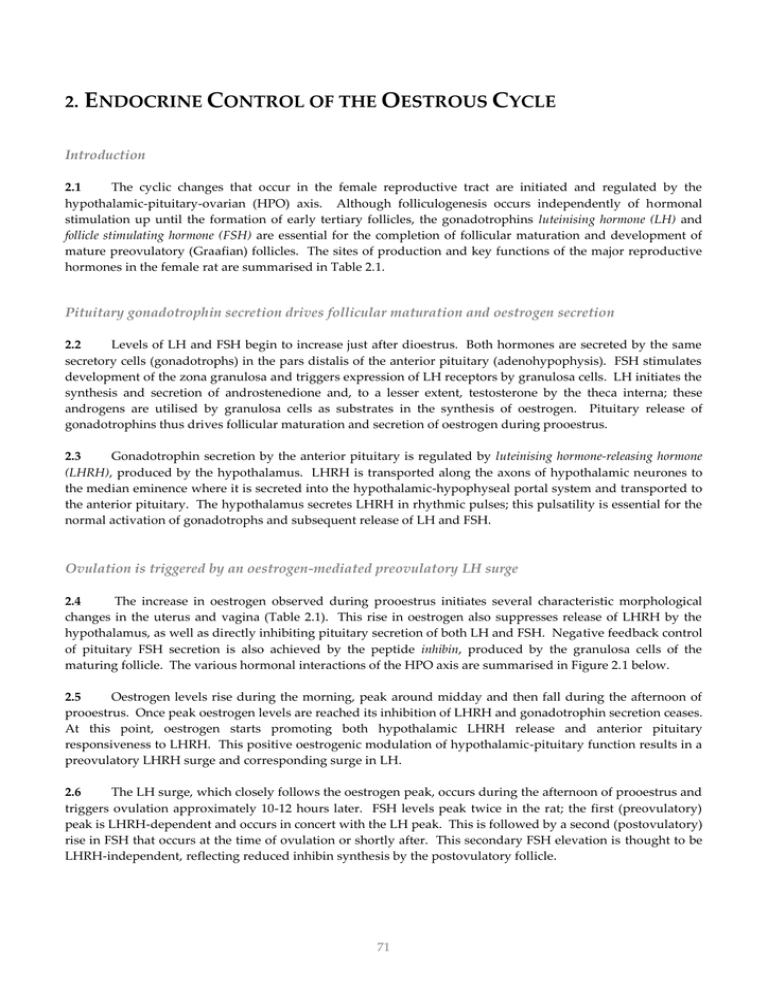
2. ENDOCRINE CONTROL OF THE OESTROUS CYCLE Introduction 2.1 The cyclic changes that occur in the female reproductive tract are initiated and regulated by the hypothalamic-pituitary-ovarian (HPO) axis. Although folliculogenesis occurs independently of hormonal stimulation up until the formation of early tertiary follicles, the gonadotrophins luteinising hormone (LH) and follicle stimulating hormone (FSH) are essential for the completion of follicular maturation and development of mature preovulatory (Graafian) follicles. The sites of production and key functions of the major reproductive hormones in the female rat are summarised in Table 2.1. Pituitary gonadotrophin secretion drives follicular maturation and oestrogen secretion 2.2 Levels of LH and FSH begin to increase just after dioestrus. Both hormones are secreted by the same secretory cells (gonadotrophs) in the pars distalis of the anterior pituitary (adenohypophysis). FSH stimulates development of the zona granulosa and triggers expression of LH receptors by granulosa cells. LH initiates the synthesis and secretion of androstenedione and, to a lesser extent, testosterone by the theca interna; these androgens are utilised by granulosa cells as substrates in the synthesis of oestrogen. Pituitary release of gonadotrophins thus drives follicular maturation and secretion of oestrogen during prooestrus. 2.3 Gonadotrophin secretion by the anterior pituitary is regulated by luteinising hormone-releasing hormone (LHRH), produced by the hypothalamus. LHRH is transported along the axons of hypothalamic neurones to the median eminence where it is secreted into the hypothalamic-hypophyseal portal system and transported to the anterior pituitary. The hypothalamus secretes LHRH in rhythmic pulses; this pulsatility is essential for the normal activation of gonadotrophs and subsequent release of LH and FSH. Ovulation is triggered by an oestrogen-mediated preovulatory LH surge 2.4 The increase in oestrogen observed during prooestrus initiates several characteristic morphological changes in the uterus and vagina (Table 2.1). This rise in oestrogen also suppresses release of LHRH by the hypothalamus, as well as directly inhibiting pituitary secretion of both LH and FSH. Negative feedback control of pituitary FSH secretion is also achieved by the peptide inhibin, produced by the granulosa cells of the maturing follicle. The various hormonal interactions of the HPO axis are summarised in Figure 2.1 below. 2.5 Oestrogen levels rise during the morning, peak around midday and then fall during the afternoon of prooestrus. Once peak oestrogen levels are reached its inhibition of LHRH and gonadotrophin secretion ceases. At this point, oestrogen starts promoting both hypothalamic LHRH release and anterior pituitary responsiveness to LHRH. This positive oestrogenic modulation of hypothalamic-pituitary function results in a preovulatory LHRH surge and corresponding surge in LH. 2.6 The LH surge, which closely follows the oestrogen peak, occurs during the afternoon of prooestrus and triggers ovulation approximately 10-12 hours later. FSH levels peak twice in the rat; the first (preovulatory) peak is LHRH-dependent and occurs in concert with the LH peak. This is followed by a second (postovulatory) rise in FSH that occurs at the time of ovulation or shortly after. This secondary FSH elevation is thought to be LHRH-independent, reflecting reduced inhibin synthesis by the postovulatory follicle. 71 The rat corpus luteum is functionally short-lived and regresses in the absence of prolactin stimulation 2.7 Progesterone levels start to increase during prooestrus and peak during ovulation. Like oestrogen, progesterone feedback control of hypothalamic-pituitary function may be negative or positive, depending on the stage in the oestrous cycle. Following ovulation, progesterone synergises with oestrogen to inhibit gonadotrophin secretion. Conversely, rising progesterone levels during prooestrus trigger hypothalamic LHRH secretion, stimulating gonadotrophs in the anterior pituitary and reinforcing the preovulatory LH surge. 2.8 After ovulation, luteinisation of the follicular granulosa and thecal cells occurs resulting in the formation of the corpus luteum. The rat corpus luteum secretes progesterone autonomously for approximately 48 hours before becoming non-functional and degenerating over the course of several subsequent oestrous cycles. 2.9 Prolongation of corpus luteum function requires continued pituitary secretion of prolactin, a luteotrophic and luteolytic hormone in the rat. Prolactin levels peak and fall simultaneously with the preovulatory prooestrus LH surge in normally cycling rats; this is followed by a secondary surge of prolactin around the afternoon of oestrus. The prooestrus surge of this hormone is thought to promote the lysis of corpora lutea from previous oestrous cycles. 2.10 Copulation during oestrus causes vaginocervical stimulation which triggers, via a neuroendocrine reflex, twice daily prolactin release by lactotrophs in the adenohypophysis. This mating-induced prolactin secretion is luteotrophic in effect and disrupts normal oestrous cyclicity by maintaining the newly formed corpus luteum in a functional state, thus prolonging dioestrus. 2.11 The continued secretion of progesterone during this lengthened dioestrus phase initiates development of the endometrium in preparation for implantation of the fertilised ovum, as well as initiating and maintaining vaginal mucification (Table 2.1). If the mating is sterile or implantation fails to occur the corpus luteum regresses, terminating the prolonged dioestrus phase (referred to as pseudopregnancy) after 12-14 days and allowing resumption of normal reproductive cyclicity. 72 Table 2.1 – Major reproductive hormones in the female rat: sources and key functions. HORMONE SOURCE LUTEINISING HORMONERELEASING HORMONE (LHRH) Hypothalamus LUTEINISING HORMONE (LH) FOLLICLE STIMULATING HORMONE (FSH) OESTROGEN KEY FUNCTIONS Pulsatile secretion of LHRH stimulates gonadotrophs in anterior pituitary Triggers release of luteinising hormone (LH) and follicle stimulating hormone (FSH) Anterior pituitary (adenohypophysis) Stimulates production of androstenedione and testosterone by theca interna Follicular granulosa cells utilise androgens in synthesis of oestrogen LH surge triggers ovulation Anterior pituitary (adenohypophysis) Stimulates development of follicular granulosa cells Upregulates granulosa cell LH receptor expression Negative and positive feedback control of hypothalamic-pituitary function Stimulates: - proliferation and cornification of vaginal epithelium - increased vascular permeability - neutrophil infiltration of vaginal epithelium and uterine endometrium - proliferation of endometrial stromal fibroblasts and epithelial cells - hypertrophy of uterine myometrium Negative and positive feedback control of hypothalamic-pituitary function Stimulates: - mucification of vaginal epithelium† - activation and differentiation of endometrial stromal fibroblasts† - endometrial gland secretion - hypertrophy of uterine myometrium Preovulatory (Graafian) follicle PROGESTERONE Postovulatory follicle (corpus luteum) PROLACTIN Anterior pituitary (adenohypophysis) Has both luteotrophic and luteolytic functions in the rat Vaginocervical stimulation triggers prolactin secretion by lactotrophs INHIBIN Preovulatory (Graafian) follicle Negative feedback control of pituitary FSH secretion †requires 73 priming with oestrogen Figure 2.1 – Hormonal interactions of the HPO axis. Pulsatile release of luteinising hormone-releasing hormone (LHRH) by the hypothalamus drives pituitary secretion of gonadotrophins. The ovarian steroids oestrogen and progesterone exert feedback control at the level of the hypothalamus and pituitary. 74
